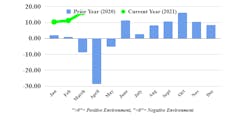FTR Intel’s Trucking Conditions Index (TCI) for March surged to a record high reading of 16.27, which is up about five points from February.
The prior record was 16.17 in October 2020, FTR said. Contributions from freight volume, rates, and capacity utilization all strengthened in March. The TCI should remain in positive double-digit territory at least through the third quarter, with the possibility of one or more record readings.
Details of the March TCI are found in the May 2021 issue of FTR’s Trucking Update, published April 30, along with additional analysis of the flatbed market segment. Beyond the TCI and additional commentary, the Trucking Update includes data and analysis on load volumes, the capacity environment, and rates.
“March’s record TCI was especially remarkable considering that the index’s fuel component—the month’s lone weakness—was the most negative it had been since before the Great Recession,” said Avery Vise, FTR’s vice president of trucking. “Robust demand and tight capacity no doubt are big operational headaches for many trucking operations, but those factors are supporting the best market conditions ever for carriers. We have yet to see signs of a loosening in driver capacity, so the near-term outlook is strong.
“A longer-term risk is that extraordinary levels of consumption—especially of durable goods—set the stage for softness in 2022 and beyond. In a sense, therefore, today’s supply chain shortages might prove beneficial by stretching out the period of solid consumer demand.”
The TCI tracks the changes representing five major conditions in the U.S. truck market: freight volumes, freight rates, fleet capacity, fuel price and financing. The individual metrics are combined into a single index indicating the industry’s overall health. A positive score represents good, optimistic conditions. Conversely, a negative score represents bad, pessimistic conditions. Readings near zero are consistent with a neutral operating environment, and double-digit readings in either direction suggest significant operating changes are likely.
